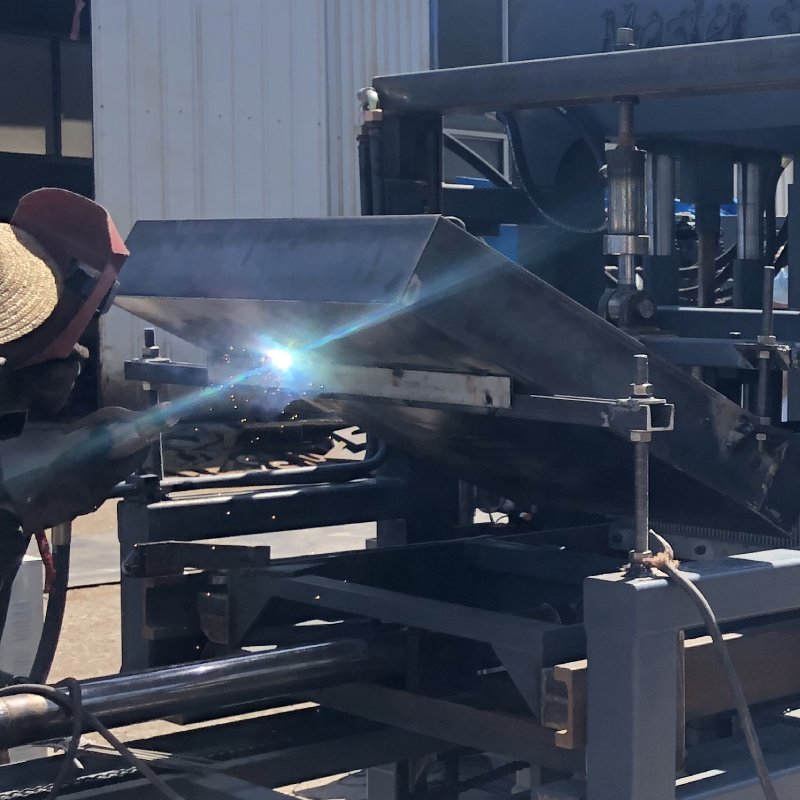
Image source:Aiwei block machine
Introduction:
The field of robotics has witnessed remarkable advancements in recent years, revolutionizing various industries and sectors. Brick making machines, which have long been an integral part of the construction industry, are also benefiting from these advancements. The integration of robotics in brick making machines has the potential to enhance efficiency, productivity, and quality in the brick production process. In this article, we will analyze the role of robotics in enhancing brick making machine efficiency and explore the various ways in which robotics technology is transforming the industry.
Automated Material Handling:
One of the key areas where robotics is enhancing efficiency in brick making machines is in material handling. Traditionally, the movement and placement of raw materials, such as clay or concrete, required manual labor, which can be time-consuming and labor-intensive. However, with the introduction of robotics, automated material handling systems can now be incorporated into brick making machines. Robotic arms and grippers can precisely and efficiently handle the materials, reducing the need for human intervention and improving overall productivity. This automation streamlines the production process, minimizes errors, and optimizes material usage, leading to increased efficiency and reduced wastage.
Precise and Consistent Brick Manufacturing:
Robotics technology plays a crucial role in ensuring precise and consistent brick manufacturing. Robotic systems can be programmed to perform precise movements, measurements, and alignments during the molding and compacting processes. This level of precision results in consistent brick dimensions, shapes, and surface finishes, eliminating variations that may occur due to human error. The use of robotics ensures that each brick meets the desired quality standards, enhancing the overall efficiency and reliability of the brick making process.
Quality Control and Inspection:
Maintaining high-quality standards is essential in the brick manufacturing industry. Robotics technology enables automated quality control and inspection processes, improving efficiency and accuracy. Vision systems, equipped with advanced cameras and image processing algorithms, can be integrated into brick making machines to inspect each brick for defects, such as cracks, chips, or inconsistencies. The use of robotics in quality control reduces the reliance on manual inspection, speeds up the process, and ensures a higher level of accuracy and consistency in detecting and rejecting faulty bricks. This enhances overall efficiency by minimizing the production of defective bricks and reducing waste.
Automation of Brick Stacking and Packaging:
Brick stacking and packaging are labor-intensive tasks that can be time-consuming and physically demanding. Robotics technology offers automated solutions for these processes, improving efficiency and reducing the reliance on manual labor. Robotic systems can be programmed to stack bricks in predetermined patterns, align them accurately, and package them efficiently. This automation not only speeds up the stacking and packaging processes but also ensures uniformity and consistency in the final product. Additionally, robotics technology allows for the integration of automated palletizing and warehouse management systems, further optimizing efficiency in logistics and storage.
Maintenance and Troubleshooting:
Robotics technology plays a significant role in enhancing the maintenance and troubleshooting capabilities of brick making machines. Advanced robotic systems can be equipped with sensors and monitoring devices that continuously gather data about the machine’s performance, temperature, vibrations, and other relevant parameters. This real-time data allows for predictive maintenance, where potential issues can be identified before they escalate into major problems, reducing downtime and enhancing overall machine efficiency. Additionally, robotics technology enables remote monitoring and diagnostics, where experts can remotely analyze the machine’s performance and troubleshoot issues, further minimizing disruptions and maximizing efficiency.
Integration with Digital Technologies:
The integration of robotics in brick making machines opens up opportunities for seamless integration with digital technologies, such as artificial intelligence (AI), machine learning, and data analytics. These technologies can enhance efficiency by optimizing production processes, predicting maintenance needs, and analyzing data for process improvement. For example, AI algorithms can analyze data collected by robotic sensors to identify patterns, optimize machine settings, and improve production efficiency. Furthermore, data analytics can provide valuable insights into production trends, material utilization, and energy consumption, enabling informed decision-making and further enhancing overall efficiency.
Worker Safety and Ergonomics:
Robotics technology not only enhances machine efficiency but also improves worker safety and ergonomics. By automating labor-intensive tasks, such as material handling and brick stacking, robotics reduces the physical strain on workers and minimizes the risk of injuries associated with repetitive motions or heavy lifting. This leads to a safer and healthier work environment, enhancing worker well-being and productivity.
Scalability and Adaptability:
Robotics technology offers scalability and adaptability to brick making machines. As construction projects vary in scale and complexity, robotic systems can be easily adjusted and programmed to accommodate different production requirements. Whether it’s a small-scale housing project or a large-scale infrastructure development, the flexibility of robotics allows brick making machines to adapt to changing demands, ensuring efficient production regardless of project size.
Conclusion:
Robotics technology is revolutionizing the brick making industry by enhancing efficiency, productivity, and quality in the production process. From automated material handling to precise brick manufacturing, automated quality control, and inspection to robotic brick stacking and packaging, robotics offers numerous benefits. Additionally, robotics technology improves maintenance and troubleshooting capabilities, enables seamless integration with digital technologies, and opens up new avenues for process optimization. As the field of robotics continues to advance, we can expect further enhancements in brick making machine efficiency, leading to increased productivity, reduced costs, and improved overall sustainability in the construction industry. The integration of robotics in brick making machines represents a significant step forward in the pursuit of more efficient and sustainable construction practices.
